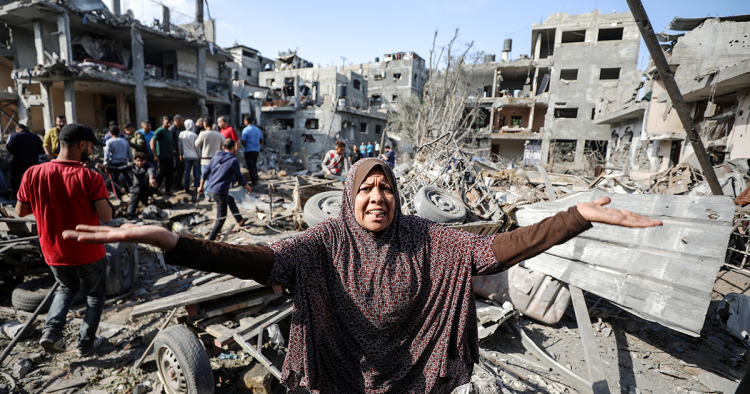The growing ferocity of Israel’s military offensive on Gaza amid continued rocket attacks by Hamas has largely overtaken the original crisis that triggered it just 50 miles away in Israeli-occupied East Jerusalem. The current crisis began earlier this month with Palestinian demonstrations against the imminent expulsion of some eighteen families in the Sheikh Jarrah neighborhood in order to put Israeli settlers in their place. The expulsions are part of a broader effort by radical settler groups and Israeli authorities targeting the homes of dozens of Palestinian families. Palestinian demonstrators were met with a massive show of force by Israeli authorities who responded with tear gas, stun grenades, sponge-tipped bullets, and beatings, leading to hundreds of injuries. As the protests spread to other parts of the city so did the violent Israeli crackdown, including nightly raids by Israeli forces at the Al-Aqsa Mosque compound, even as thousands of right-wing Jewish marchers descended on the Old City in commemoration of Jerusalem Day.
The scale and brutality of the crackdown, along with the assault on Islam’s third holiest site during the Muslim holy month of Ramadan, virtually guaranteed an escalation. And sure enough, seeing an opportunity to assert itself as defenders of Al-Aqsa, Hamas launched a barrage of rockets on Israel, which in turn triggered massive air and artillery assault on Gaza by Israel. The latest Israel-Hamas conflagration, which shows no sign of letting up, has so far resulted in the deaths of 122 Palestinians and six Israelis, most of them civilians, with hundreds more wounded.
If all of this feels familiar, it’s because it is. The current dynamics are eerily similar to 2014 when a series of violent provocations in the West Bank and East Jerusalem led to eight weeks of largescale death and destruction, most of it in Gaza. While there is no shortage of violent flashpoints in Israel/Palestine, including most recently mob violence between Arabs and Jews inside Israel itself, for the past several years Gaza and East Jerusalem have been the two most prominent venues of recurring violence and unrest, sometimes together and sometimes separately but always simmering just beneath the surface.
But why does it keep happening? On the surface, the conditions in Gaza, with its impoverished and densely packed population of two million and which has been governed by the Islamist militant group Hamas since 2007, and Israeli-occupied East Jerusalem, home to 350,000 Palestinians and which has been formally annexed by Israel, seem vastly different. In reality, Gaza and East Jerusalem have one critical feature in common as the two areas where Israeli control over Palestinian lives and livelihoods is most pronounced and most oppressive, albeit for vastly different reasons—Gaza because Israel hopes to be rid of it once and for all and East Jerusalem because Israel seeks to consolidate permanent control over it. The crushing weight of the seemingly endless blockade on Gaza and the relentless drive to Judaize and de-Palestinianize East Jerusalem have made both areas prime flashpoints for chronic turmoil and bloodshed.
Ironically, Gaza and East Jerusalem are also the two areas that Israel insists, quite implausibly, are not under occupation. Despite withdrawing its soldiers and settlers from Gaza in 2005, the international legal consensus is that Israel—which continues to control Gaza’s air, land and sea borders, and even civilian matters like taxation and the population registry—remains the occupying power there. Likewise, Israel’s annexation of East Jerusalem is not recognized by the bulk of the international community.
Israeli policies in East Jerusalem are driven by two parallel goals: to maximize the Jewish presence and character of the city while minimizing the Palestinian ones. Denied services from Israel and cut off from the Palestinian Authority, East Jerusalem and its roughly 350,000 Palestinians live in a kind of social and political limbo. In addition to being physically isolated from the West Bank and internally fragmented by Israeli settlements and the separation wall, the city’s Palestinian population is subjected to a wide array of officially sanctioned (and well documented) discriminatory policies in nearly all facets of life, including taxation, housing, building permits, education, water, health services, and residency rights. Despite making up around 38 percent of the city’s population, Palestinians in Jerusalem receive just 12 percent of the municipal budget. Since 1967, more than 14,000 Palestinian Jerusalemites have had their residency rights revoked by Israel, with over half of these revocations occurring since 2006. Meanwhile, around 80 percent of Jerusalem’s Palestinians live below the poverty line. The marginalization and denationalization of Palestinian Jerusalemites by Israel has only intensified in recent years, including the systematic eradication of Palestinian national, civic, and even cultural institutions. The pending expulsions in Sheikh Jarrah and other East Jerusalem neighborhoods have heightened the Palestinians’ sense of existential threat.
Photo by Ali Jadallah/Anadolu Agency via Getty Images
The Middle East Institute (MEI) is an independent, non-partisan, non-for-profit, educational organization. It does not engage in advocacy and its scholars’ opinions are their own. MEI welcomes financial donations, but retains sole editorial control over its work and its publications reflect only the authors’ views. For a listing of MEI donors, please click here.













